Part 3 discusses the measures adopted in FY2005 for the promotion of science and technology, in line with the Second Science and Technology Basic Plan.
3.1 Development of Science and Technology Policies
The Science and Technology Basic Law was promulgated and put into effect on November 15, 1995. Based on a recognition of the important role that science and technology should play in the development of Japan’s economy and society, in the improvement of the welfare of the nation, and in the sustainable development of human society, the objective of this law is to achieve higher standards of science and technology through the promotion of such measures as the implementation of the Science and Technology Basic Plan, etc., for the comprehensive and systematic promotion of science and technology.
Article 9 of the Law stipulates that the government must draw up a basic plan for science and technology, for the purpose of the comprehensive and systematic promotion of measures for the promotion of science and technology.
3.1.1 The Science and Technology Basic Plan
The Second Science and Technology Basic Plan, approved at a Cabinet meeting in March 2001, was formulated and carried out during the period of prolonged economic stagnation in Japan following the collapse of the bubble economy. Even amid the deteriorating financial conditions, however, government research and development investment increased, and a broad range of structural reforms were carried out including: strategic priority setting in science and technology through promotion of basic research and prioritization of research and development activities covering topics of interest to the government and society; development of a competitive research and development environment by increasing competitive funds and reforming existing systems; and reorganization of national research institutes and national universities into corporations. At the meeting of the Council for Science and Technology Policy (CSTP) on December 27, 2004, the Prime Minister submitted an inquiry regarding basic policies on science and technology in order to formulate a science and technology basic plan for the five years beginning Fiscal 2006. Following examinations and discussions lasting a year, the CSTP issued a recommendation on Inquiry No. 5 “Japan’s Science and Technology Basic Policy Report” at the council meeting held on December 27, 2005. Based on that recommendation, the Cabinet officially launched the Third Science and Technology Basic Plan (hereinafter referred to as the “Basic Plan”) on March 28, 2006 after consultations by the CSTP (see section 1.3.1).
The Basic Plan primarily focuses on “S&T to be supported by the public and to benefit society” and “emphasis on fostering human resources and competitive research environments,” and basically complies with three concepts laid down in the Second Basic Plan: “a nation contributing to the world by creation and utilization of scientific knowledge;” “a nation with international competitiveness and ability for sustainable development;” and “a nation securing safety and quality of life.” Based on the concepts, the Basic Plan provides six more detailed policy goals: 1.Quantum jump in knowledge, discovery, and creation; 2.Breakthroughs in advanced S&T; 3.Economic growth & environmental protection; 4.Innovator Japan; 5.Nation’s good health over lifetime; and 6.The world’s safest country. In order to achieve the goals, the Basic Plan emphasizes high-quality basic research, and, with respect to research and development on topics of interest to the government and society, proposes that funds are preferentially allocated to four areas including life sciences, information and telecommunications, environmental sciences, and nanotechnology/materials. In addition, the Basic Plan aims at inter-sectoral prioritization, by providing promotion strategies for each of the eight areas and selecting the “strategically focused science and technology” that requires intensive investment during the period of the plan. It also states that the mission of science and technology for the next five years is to resolve a broad range of policy issues such as development of a large amount of human resources who can produce excellent research findings, creation of a competitive environment, strategic investment to promote science and create innovation on a constant basis, and removal of systematic or operational obstacles to returning the results to society. The fiscal situation in Japan is the worst among major developed countries, and the promotion of financial structural reforms focusing on both revenues and expenditures is indispensable in creating a proactive society and dynamic economy and achieving sustainable growth. From the viewpoint of making ongoing efforts to promote science and technology following the Second Basic Plan, the Basic Plan states the target to raise the ratio of government research and development investment to GDP to the level of the U.S. and major European countries. Specifically, a total of about 25 trillion yen in government R&D investment is required in the five-year period from Fiscal 2006 to Fiscal 2010 (Figure 3-1-1).
(Note) Figures are based on the presumption that government research and development investment will be 1% of GDP during the period of the Basic Plan, with a nominal GDP growth rate of 3.1%.
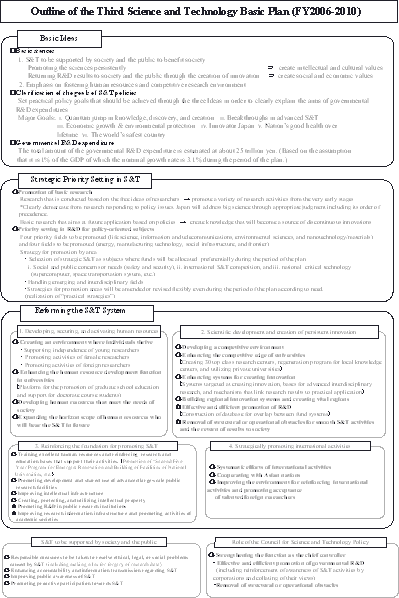
Figure 3-1-1 Main points of the Third Science and Technology Basic Plan(FY2006-FY2010)
In view of the above, while taking into consideration future social and economic trends, the necessity for the promotion of science and technology, and fiscal conditions that are even more severe than they were during the period of the Second Basic Plan, Japan should be striving to increase the funds necessary to promote the policies presented in the Basic Plan, in order to achieve the maximum possible positive impact from government R&D investment through steady implementation of science and technology system reforms laid out under that plan.
3.1.2 The Council for Science and Technology Policy
Since its establishment in January 2001, the Council for Science and Technology Policy (Figure 3-1-2, 3-1-3) has generally met once a month with the participation of the Prime Minister as council chairman (a total of 53 sessions as of March 2006). The major items discussed and ratified during Fiscal 2001 are as presented below.
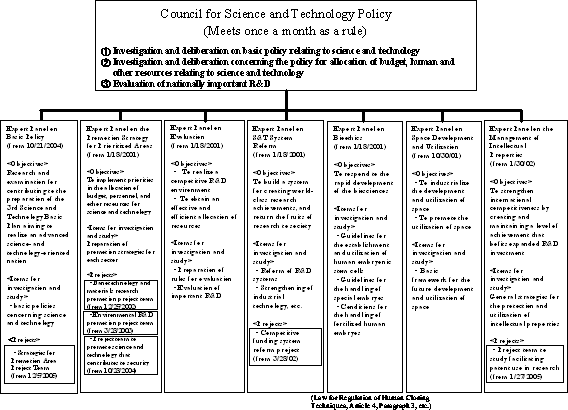
Figure 3-1-2 Organization of the Council for Science and Technology Policy
Table 3-1-3 Chairman and Members of the Council for Science and Technology Policy(as of the end of March 2006)
|
(1) Reform of Science- and Technology-Related Budget for Fiscal 2006
As Fiscal 2006 is the first year of the Third Science and Technology Basic Plan and in order to achieve the various objectives for realizing an advanced science- and technology-oriented nation as set forth in the Plan, the Council strengthened efforts for high-quality measures by promoting the reform of the science- and technology-related budget, including thorough implementation of "core business concentration," in order to make the budget appropriate for the first year of the Basic Plan.
● Improvement of prioritization(SABC, etc.)
In formulating the Fiscal 2006 budget, the Minister of State for Science and Technology Policy and the eminent members of the Council, with the cooperation of outside experts, prioritized (in 4 levels: S, A, B, and C) the science- and technology-related measures for which relevant ministries and agencies made budget requests, and then, with regard to independent administrative institutions, etc., summarized opinions on their main projects related to science and technology. (October 18, 2005). The prioritization results were as follows:
S:24 items (12%) ─ Particularly important research topics that require
aggressive implementation
A:72 items (37%) ─ Important research topics
that require steady implementation
B:78 items (40%) ─ Items for which
problems must be solved and that need effective and efficient implementation
C:19
items (10%) ─ Items requiring review of research details, plans, and promotion
systems
28% of the total budget was allocated to the S group, 34% to the A group, 35% to the B group, and 3% to the C group.
In addition, working to enhance the science and technology budget, the CSTP made a summary of “Toward Formation of the Fiscal 2006 Science and Technology-Related Budget (Opinion),” and submitted its opinion to the Prime Minister and the relevant ministers (November 28, 2005).
With the recognition that the promotion of science and technology is “investment in the future,” expenses for the promotion of science and technology were increased 1.1% in the Fiscal 2006 budget from the previous fiscal year, despite the fact that the general expenditures for the fiscal year were reduced drastically. Incidentally, the total science- and technology-related budget, including expenses other than for the promotion of science and technology, was reduced by 0.1%.
● Comprehension of science and technology activities conducted by independent administrative institutions and national universities, and the publication of opinions offered regarding the activities
In Fiscal 2005, the CSTP began to compile the “Comprehension of Science and Technology Activities Conducted by Independent Administrative Institutions and National Universities, and the Publication of Opinions Offered Regarding the Activities” in order to grasp science and technology-related activities conducted by independent administrative institutions and national universities, which operate mainly based on grants for administration that are difficult to specify the detailed use during the compilation of the budget. Specifically, this report aims to present the CSTP's opinions on issues such as compliance with the Science and Technology Basic Plan, based on the examination and analysis of various indicators including the number of theses released by such entities.
● Promotion of the coordination program ofscience and technology projects
As a new method to remove the harmful effects of sectionalism and enhance collaboration between relevant ministries and agencies, the Coordination Program for Science and Technology Projects was promoted for the following eight themes that are important nationally and socially and that should be promoted with collaboration between ministries and agencies: 1.Post-genome - Promotion of health sciences -, 2.New or revived infectious diseases, 3.Ubiquitous Networks - RFID tags and technologies, - 4.Next-Generation Robots -Shared platform technology-, 5.Biomass utilization, 6.Hydrogen and fuel cell technology, 7.Nano-biotechnology, 8.Regional Cluster.
● Thorough reform and focused expansion of competitive research funding
In order to promote creative R&D activities, it is necessary to develop a competitive R&D environment. To this end, institutional reform has continued to be implemented thoroughly to maximize the effect of competitive research funding, and focused expansion of funding has been carried out along with more effective distribution of funds through elimination of unnecessary duplication of resource use and prevention of excessive concentration on R&D projects.
As a result, 470.1 billion yen was appropriated for competitive funding purposes (up 0.6% over the previous year) in the Fiscal 2006 budget.
(2) Resources Allocation Guidelines for Science and Technology Budget/Human Resources
As shown in the Basic Plan, the CSTP relies on the Basic Plan and the sectoral promotion strategy, etc., examines the science and technology measures set forth for the next fiscal year, and presents opinions to the Prime Minister regarding those measures that it believes merit particular priority, and then clarifies its ideas regarding the next fiscal year’s important measures and allocation of resources, and presents those ideas to the relevant ministers. Furthermore, to ensure that the resource allocations settled upon in the CSTP are carried out, the council coordinates when necessary with the finance authorities during the budget formulation process.
● Adoption of Fiscal 2006 resources allocation guidelines for science and technology budget/human resources and presentation of opinions thereon (June 16, 2005)
As Fiscal 2006 is the first year of the Third Science and Technology Basic Plan, the Fiscal 2006 guidelines aim at strategic priority setting based on thorough implementation of “selection and concentration” in compliance with the directions such as 1.science and technology to be supported by the public and to benefit society, 2.concepts of the Third Science and Technology Basic Plan and policy goals, 3.importance of human resource development and the competitive environment - shift in emphasis from “hard” to “soft”, e.g. human resources; greater significance of individuals at institutions.
Specifically, the guidelines presented principles to be emphasized with regard to 1.strategic priority setting in science and technology (promotion of basic research and prioritization of research and development on policy issues, etc.,) 2.promotion of science and technology system reforms, and 3.science and technology to be supported by the public and society.
(3) Major Efforts of the Council for Science and Technology Policy in Fiscal 2005
● Examination of promotion measures in priority areas
Based on the prioritized strategies determined in the Basic Plan, in Fiscal 2001 the CSTP prepared the “Sectoral Promotion Strategy” for eight major areas, which are the Life sciences, Information and communications, Environmental sciences, Nanotechnology/Materials, Energy, Manufacturing technology, Social infrastructure and Frontier - outer space and the oceans (Figure 3-1-4). CSTP promotes measures based on the promotion strategies for these areas (see section 3.2.2).
Figure 3-1-4 Strategies for the Promotion of Each of the Four Priority Sectors(September 21, 2001)
Four Priority Sectors:
the sectors that receive particular priority
and preferential allocation of R&D resources.
Each section below features
the current situation and issues, thoughts on prioritizing and areas of priority,
five-year R&D objectives, and promotion measures for one of these sectors.
|
Life Sciences Area |
Information and Communications Area |
|---|---|
|
1.Current Situation, and Issues The 21st century is being called the "Century of Life." While Japan had a late start in analysis of the genome, the country is using its leading-edge R&D performance in SNPs, proteins, etc., to catch up in post-genome research and industrial applications. 2.Thoughts on Prioritizing, and Areas of Priority Strive to extend the "healthy life expectancy" in an aged society with fewer children, and seek to overcome the infectious diseases, allergies and stress-related illnesses that are now coming to the fore as social problems. Furthermore, achieve a prosperous lifestyle by utilizing diverse bio-resources and bio-functions, and strengthening industrial competitiveness. (1) Develop
technologies to "protect the people's health" Technologies
for the prevention and treatment of diseases that utilize genome-related
technologies to achieve active, long lives (2) Develop technologies for "competitiveness" and
"sustainable development" Materials production and environmental
response technologies that utilize bio-functions (3) Emerging and interdisciplinary areas and the development of advanced analyzing technologies. Build systems and structures that accelerate the return of the fruits of research to society. 3. Five-Year R&D Objectives (1) Realize healthy,
secure lives by: Developing countermeasures for "lifestyle
related diseases," and ailments that lead to "dementia"
and "bed-ridden status": Analyze tens of million of SNPs
each year/Perform structural and functional analysis of large-scale,
highly purified proteins/Identify approximately 10 genes related
to each ailment/Shorten drug development times/Realize effective
treatment using medicines tailor-made to the constitution of individual
patients, etc. (2) Advance technologies for the production of useful substances and technologies for separating environmental pollutants, utilizing genome-related technologies and microorganisms and other plants and animals/Develop crops resistant to environmental stresses to improve food supply capabilities (3) Promote research into interdisciplinary sectors such as bio-informatics and nanobiology/Promote clinical research/Arrive at consensus in bioethics/Promote social acceptance of genetically modified organism/Promote accumulation of intellectual properties, etc. 4. Promotion Measures (1) Build up comprehensive systems of promotion for the evaluation of, and guidance on, measures proposed by various ministries that serve to strengthen national efforts (2) Develop effective collaboration among industry, academia and government, the development of systems and structures that return the fruits of research to society, etc. (3) Develop education and research centers for developing human resources for such interdisciplinary sectors as bio-informatics, advanced analysis, and medical treatment device development, in which engineering, physical sciences, medical science, agriculture, etc., are utilized and integrated |
1. Current Situation and Issues While the gap between Japan and the United States in information and communications technology continues to widen, R&D investment growth in the private sector is stalling, and collaboration among industry, academia, and the government remains insufficient. Since Japan's economy relies heavily on the information and communications industry, strengthening international competitiveness is an urgent task. 2.Thoughts on Prioritizing and Areas of Priority Prioritize from the viewpoints of strengthening international competitiveness in the core technologies in which Japan has an advantage, such as mobile, optical and device technologies, the achievement of safe, secure and comfortable lives, strengthening the foundation for next-generation information and communications technologies and R&D infrastructure.
Technologies that realize an ultra-high-speed mobile internet
system, in which vast amounts of information can be exchanged and
utilized with high quality through wireless and optical networks
anywhere and anytime, whether at home, in the office or on the move
3. Five-Year R&D Objectives (1) Information and
communications system with high-speed and highly reliability. Realize
wireless access in the class of tens of megabits per second, fully
optical networks at 10 terabits per second, ultra-large scale connections
(nodes) with IPv6, and high-quality real-time transmissions, and
mobile terminals with 1-gigahertz-class high-speed and advanced
functionality that do not require recharging for a week at a time,
etc. (2) Next-generation information and communications technologies: Realize technologies that can understand user intention by considering surrounding conditions, quantum code key distribution over relatively short distances, advanced ITS using next-generation Internets, gigabit-class high-speed space communications, etc. (3) R&D infrastructure: Realize electronic science and technology information and search systems, and joint supercomputer networks linking national research institutions and universities, etc. 4. Promotion Measures (1) Promotion of R&D applications: Strengthen collaboration among industry, academia, and government, etc., to promote R&D activities specifically intended for practical use, promote international standardization, and promote technology development in test beds for real environments (2) R&D systems: Promote greater movement of researchers between institutions, support and develop venture companies, utilize excellent universities and research institutions as R&D bases, develop high-level instructors in the information and communications field, and expand the scale of human resource development capabilities (3) Investigation of effects on society: Research the effects of information and communications development on society, coordinate with IT strategy headquarters, form strategic international collaborations to encourage international standardization and technology transfers, etc. |
|
Environmental Area |
Nanotechnology and Materials Area |
|
1. Current Situation, and Issues With environmental problems becoming both broader in geographical scope and more complex, research is requested to coordinate individual projects and develop planned and integrated programs. Other issues also requiring attention from a comprehensive viewpoint are research on human-environment interactions, and forecasting and preventive research (scenario-driven environmental research). 2.Thoughts on Prioritizing, and Areas of Priority Engage in research that contributes to the solution of urgent
and serious environmental problems, and to the building of sustainable
societies. Perform research promoted by scenario-driven initiatives
in which natural sciences, humanities and social sciences are merged
under inter-ministerial collaboration.
3. Five-Year R&D Objectives (1) Research into global warming: Seek possibilities for controlling the emission of greenhouse gases into the atmosphere so as not to endanger mankind and ecosystems, and examine obtaining and systemizing scientific knowledge, developing and advancing remedy technologies and creating scenarios for the control of global warming. (2) Research into waste-free and resource recycling technologies: Develop technologies and systems that contribute to the reduction of waste volumes, improvement of recycling and reutilization rates, and reduction of environmental risks from toxic wastes. (3) Research into eco-harmonious river basin and urban area regeneration: Propose measures for the resolution of such environmental problems as high environmental loads in urban areas and the retreat or deterioration of natural environments, and systematically develop riparian district and urban renewal technologies and systems in order to contribute to the preparation of specific plans for coexistence with nature in major urban areas (4) Research into chemical substance risk management: While determining the chemical substances that are expected to need risk management, urgently build up the technological infrastructure, knowledge systems, and intellectual infrastructure for comprehensive management of chemical substances, to ensure "safety and security" (5) Research into global water cycle: Provide the scientific knowledge and technological infrastructure required for assessing the effects on human society of water resource supply and demand and changes in the water cycle, and for establishing water management methods that lead to sustainable development (6) Intellectual infrastructure for the environmental area: Broaden and upgrade the intellectual infrastructure for environmental research (7) Promotion of advanced research: Develop innovative knowledge for the resolution of environmental problems, and build new paradigms 4. Promotion Measures (1) Improvement of R&D quality: (1)Establish promotion and evaluation systems for initiatives, Foster international cooperation, (2)Disseminate R&D results, reflected in environmental policies, and basic efforts on societal understanding, (3) Define roles and foster cooperation among industry, academia, and government, (4) Cooperate with initiatives by local governments and NGOs, etc. (2) Necessary resources: (1) Enhance and expand competitive funding,(2)Assure and develop human resources, strengthen international research networks, improve systems for accepting foreign researchers, and support and actively utilize environment-related university institutions, (3) Cooperate with other sectors: actively utilize new methods and technologies in other sectors in order to engender reform of environment research paradigms, (4) Develop important large-scale facilities and equipments specific to environmental research |
1.Current Situation, and Issues Nanotechnology offers great possibilities for technological innovation in a wide range of industries. Nations everywhere are actively engaged in strategic efforts. In materials technology, competitiveness arises from high value-added functional materials. 2.Thoughts on Prioritizing, and Areas of Priority Assign priorities from the perspectives of "strengthening industrial competitiveness and forming the basis for sustainable economic growth," "responses to environmental and energy problems, and to an aged society with few children," and "assurance of safe and secure lives for the people, and retention of strategic technologies." Clarify the timetable for technological development, and steadily implement basic measurement, evaluation, and processing technologies, as well as materials technologies, etc.
3. Five-Year R&D Objectives
4. Promotion Measures
|
Four Other Fundamental Areas: areas that are fundamental to the existence of the nation, and that are emphasized as areas in which it is essential for Japan to be involved:
|
Energy Area |
Manufacturing Technology Area |
|---|---|
|
1. Areas of Priority and Five-Year Objectives.. (1) R&D that brings about a reform of the total energy system,
including supply, transportation, conversion, and consumption (2) R&D essential for upgrading the energy infrastructure (3) R&D for safe and secure energy (4) R&D that comprehensively evaluates and analyzes energy
both socially and economically ※ Five-year objectives have been established for the above items. 2. Promotion Measures.. 1. Important items for improving the quality and efficiency of R&D: (1) Creation of results that are transferable to developing countries, and active use of international cooperation through participation in international joint research (2) R&D efforts and evaluation under the conditions of the level of social understanding of R&D results and the diffusion of them (3) To recognize each role for, and collaboration among, industry, academia and the government in order to promote the efficient development of system technologies (4) Efficient promotion through inter-ministerial coordination of cross-ministerial themes (5) Consistent efforts for short-, mid-, and long-term R&D themes 2. Points of concern relating to necessary R&D resources: |
1. Areas of Priority and Five-Year Objectives..
※ Five-year objectives have been established for the above items. 2. Promotion Measures.. (1) Develop human resources; improve environments that encourage creativity (2) Accumulate fundamental knowledge, technology, and know-how (3) Intellectual property rights-related strategies (4) Review the status of collaboration among industry, academia,
and government (5) Promote the development and standardization of the intellectual infrastructure (6) Promote practical applications such as through the formation
of venture businesses |
|
Infrastructure Area |
Frontier Area |
|
1. Areas of Priority and Five-Year Objectives
※ Five-year objectives have been established for the above items. 2. Promotion Measures..
|
1. Areas of Priority and Five-Year Objectives..
※ Five-year objectives have been established for the above items. 2. Promotion Measures..
|
● Promotion of the nanotechnology and materials area
In order to promote R&D and industrialization in the nanotechnology and materials areas, the Council has been implementing projects for the “utilization of structural materials in the construction market” as “collaborative projects” among ministries and agencies based on the “Report on the Promotion of Industrial Development in the Nanotechnology and Materials Area” (opinions presented on July 23, 2003). Furthermore, the Council has been promoting R&D on technologies to combine nanotechnology and biotechnology, with the reclassification of the R&D into “nano-biotechnology” in the Coordination Program for Science and Technology Projects.
● Evaluations
1) Follow-up study of evaluations of large scale R&D projects (August 4, 2005)
The Council conducted follow-up studies on the evaluations of large-scale R&D projects (research on genome network, observations of the South Pole, the ALMA Plan, advanced metrological analysis technology and equipment development, R&D based on the Tertiary Comprehensive Ten-year Strategy to Overcome Cancer) implemented in Fiscal 2005 and presented improvements, etc. to relevant ministries.
2) Examination of the state of implementation of midterm evaluations of R&D (September 1, 2005)
The Minister of State for Science and Technology Policy and the eminent members of the Council examined the state of midterm evaluations by each ministry and agency regarding ongoing R&D projects with funding of 1 billion yen or more in the Fiscal 2005 budget. As a result, proactive efforts by ministries and agencies were observed like in the previous year, and a comparison with the previous year’s research results revealed an increase in the number of cases for which midterm evaluations were conducted, as well as a decrease in the number of cases for which long-term evaluations were not implemented. The Minister and Council members instructed ministries and agencies to conduct midterm evaluations within an appropriate timeframe, in accordance with the purpose and theme of each of the R&D issues and measures.
3) Revision of the evaluation framework for nationally important R&D projects conducted by the Council for Science and Technology Policy (October 18, 2005)
With respect to new large-scale R&D projects, the Council determined to conduct midterm evaluations, ex-post evaluations, and follow-up evaluations, in addition to conventional ex-ante evaluationw.
4) Evaluation of new large-scale R&D projects (opinions presented on November 28, 2005)
The Council conducted the ex-ante evaluation of three large R&D projects starting in Fiscal 2006 with total national expenditures of about no less than 30 billion yen (development and adoption of state-of-the art general-purpose computers of high performance, development and sharing of X-ray free electron lasers, and the Project for Strategic Promotion of Advanced Basic Technologies), and presented the results to relevant ministers.
● Management of intellectual properties“Report on the Management of Intellectual Properties” (opinions presented on May 31, 2005)
The Council presented its opinions to relevant ministers, with regard to the ideal proactive use of intellectual property by universities and colleges. These opinions were reflected in the “Intellectual Property Strategic Program 2005” compiled by the Intellectual Property Policy Headquarters in June 2005 (See Section 3.3.6.4).
● Fostering and ensuring S&T related personnel resources “On Utilization of Science- and Technology-Related Personnel Resources” (opinions presented on July 23, 2004)
Investigations and examinations were conducted in regards to fostering and ensuring the availability of the scientists, technologists, and specialists who are needed for promoting world-class research results and their utilization. The Council then presented its opinions to the relevant ministers. The report calls for 1.fostering human resources capable of exercising international leadership, 2.higher education of a world-class standard and elementary and secondary education that fosters children’s diversity and creativity, and 3.establishment of research and education environments conducive to the creation of innovative values (See Section 3.3.4).
● Response to bioethics “Basic Conceptual Approach Relating to the Treatment of Human Embryos” (July 23, 2004)
Based on Article 2 of the Supplementary Provisions of the “Law Concerning Regulation Relating to Human Cloning Technologies and Other Similar Technologies,” the Council started a discussion on the basic conceptual approach relating to the treatment of human embryos. The Council then presented its opinions to the relevant ministers. While the report in principle prohibits treating human embryos in a way that would damage the embryos, it has set forth social norms concerning the treatment of human embryos, saying that there are cases where it is necessary to approve exceptional treatment of human embryos in order to respond to people’s requests in the pursuit of happiness with regard to health and welfare (See Section 3.2.2.1.2).
● Promotion of space development and utilization “Basic Strategy for Space Development and Utilization in Japan” (opinions presented on September 9, 2004)
The Council presented its opinions on the significance of space development and utilization in consideration of recent changes in the domestic and overseas situations surrounding space development and utilization, such as importance as a national strategic technology, contribution to overall national security, and sustainable development of the earth and mankind. The report also calls for promoting space development and utilization under the basic policy of strengthening basic technologies by maintaining Japan’s capability of launching satellites when necessary and by giving top priority to ensuring reliability. (See Section 3.2.2.8)
● Promotion of science and technology conducive to safety
With various events that represent a threat to the safety of the public, such as large-scale disasters, various types of terrorism, violent crimes, and emerging and re-emerging infectious diseases becoming increasingly common in recent years, strengthening the country’s crisis management system and building a safe society have become pressing national issues. For this reason, the Project Team for Promotion of Science and Innovation for Security and Safety, established under the Expert Panel on the Promotion Strategy for Prioritized Areas in October 2004, has been conducting research and examination on science and technology to construct a safe society where people can live without anxiety, and issued the “Midterm Report on Science and Technology Conducive to Safety” in April 2005 and the “Second-half Report on Science and Technology to Conducive to Safety” in October 2005.
● Special Coordination Funds for Promoting Science and Technology
The Special Coordination Funds for Promoting Science and Technology (Chosei-hi) is a competitive research fund for promoting the systematic reform of science and technology by taking on policies which become policy initiatives for each of the other administrative agencies, based on policies laid down by the CSTP. In Fiscal 2005, the Special Coordination Funds for Promoting Science and Technology supported four topics as meriting emergency R&D efforts, -- “Emergency Survey Research on Damage Caused by the Sumatran Earthquake and the Indian Ocean Tsunami” (March 23, 2005), “Emergency Survey Research on Countermeasures against Health Problems Caused by Asbestos” (November 2, 2005), “Emergency Survey Research on Production of New Influenza Vaccine” (November 24, 2005), and “Emergency Survey Research on Countermeasures against Snow Damage Caused by Heavy Snowfall in 2005-2006, Winter Term” (January 31, 2006). (See Section 3.3.1.1.5).
(4) Efforts towards Formulation of the Third Science and Technology Basic Plan
● Follow-up to the Second Science and Technology Basic Plan
“Progress of Scientific and Technological Policies Based on the Science and Technology Basic Plan (Fiscal 2001~2005) (opinions presented on May 26, 2004)
With regard to the state of implementation of measures laid down in the Second Science and Technology Basic Plan, the Council conducted a detailed follow-up study mainly on the state of measures implemented during the three years from Fiscal 2001 to Fiscal 2003 and worked out a list of basic problems that should be dealt with in the future.
Also, as a follow-up study on the First and Second Science and Technology Basic Plan, the “Survey for Evaluation of Effects Achieved in the Basic Plan” was conducted by the National Institute of Science and Technology Policy by using Fiscal 2003-2004 Special Coordination Funds for Promoting Science and Technology (published in March 2005).
● Formulation of the Third Science and Technology Basic Plan
The Council for Science and Technology Policy, which is required to formulate basic policies on science and technology that serve as the basis for the Science and Technology Basic Plan, established the Expert Panel on basic policy in October 2004 to formulate the Third Science and Technology Basic Plan for five years starting in Fiscal 2006. The Expert Panel is composed of experts in various fields, including international politics, national security, economy, fiscal policy, laws, and business management as well as researchers. The task force has been conducting research and study on basic policies concerning science and technology after being instructed by the Prime Minister to study “Japan’s Science and Technology Basic Policy Report” in December 2004, and issued a recommendation on December 27, 2005. Upon issuance of the recommendation, the Third Science and Technology Basic Plan was adopted at a Cabinet meeting on March 28, 2006. On the same day, the Council formulated the “Sectoral Promotion Strategy” for the following eight major areas based on the prioritized strategies determined in the Basic Plan: Life sciences; Information and communications; Environmental sciences; Nanotechnoogy/Materials; Energy; MONODZUKURI (manufacturing) technology; Social infrastructure; and Frontier.
3.1.3 Administrative Structure and Budget for Science and Technology
3.1.3.1 Administrative Structure of Science and Technology
Japan’s policy concerning science and technology is based on the Science and Technology Basic Law and on the Science and Technology Basic Plan, and is also promoted through programs of the administrative organs based on the various recommendations and advice offered by the former Council for Science and Technology, and now by the CSTP. Research is carried out at national research institutions, public corporations, independent administrative institutions, universities, and university joint research institutions, and various research programs are used to promote research, and carry out preparations for a research and development environment (Figure 3-1-5).
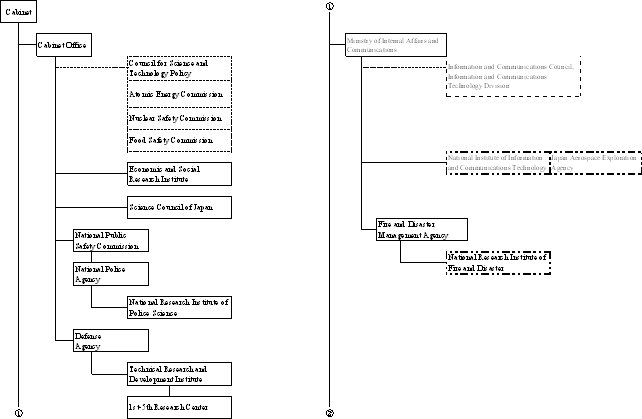
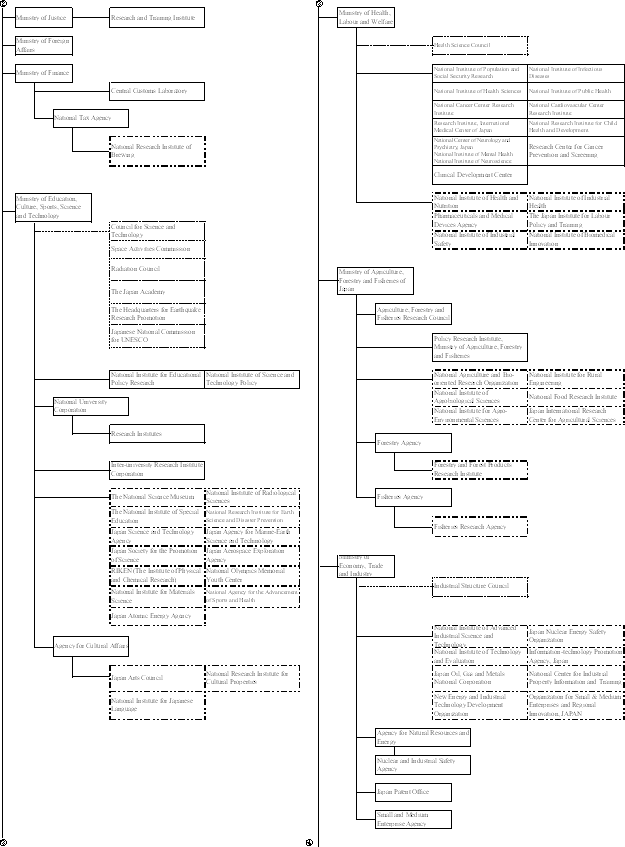
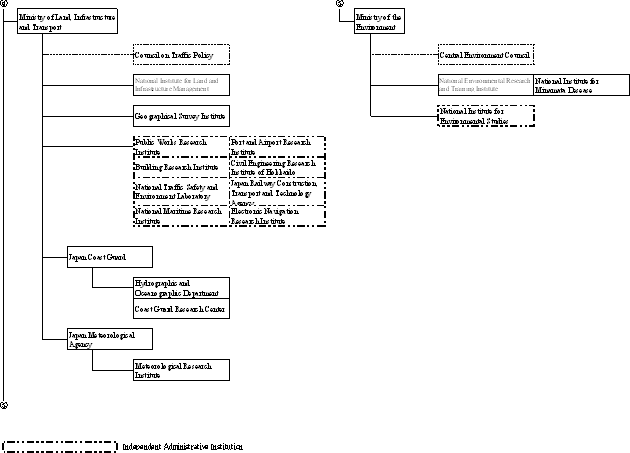
Figure 3-1-5 Japan’s Science and Technology Administrative Structure (as of March 2006)
The Council for Science and Technology Policy coordinates the science- and technology-related measures of relevant ministries and agencies as the headquarters under the leadership of the Prime Minister by examining and discussing the basic policies on science and technology, and policies on allocation of the budget, human and other resources related to science and technology. On December 27, 2005, the Council issued a recommendation to the Prime Minister with respect to the inquiry, “Japan’s Science and Technology Basic Policy Report,” in order to formulate the Science and Technology Basic Plan. The Ministry of Education, Culture, Sports, Science and Technology acts in line with those strategies to prepare specific research and development plans for individual sectors, coordinates policies for estimating costs planned by test and research institutions, etc., and administers allocations of the Special Coordination Fund for Promoting Science and Technology (SCF), in order to coordinate the management of science and technology with relevant administrative institutions. The Ministry comprehensively promotes the implementation of research and development in advanced and important science and technology fields, and the administration of science and technology that advances and strengthens creative and basic research.
In recent years, cooperation between ministries and agencies has been strengthened with the establishment of roundtable groups and inter-ministerial liaison committees concerning various research sectors and related measures, including programs for the promotion of research in brain sciences, and for basic research conducted by public corporations through public canvassing methods. Depending on the character of the respective fields or policies, these programs are promoting lateral, long-term thinking between ministries and agencies and the adoption of priority guidelines on how to promote research and development, and also promoting cooperation through the promotion of information exchanges concerning the progress of research, etc., and researcher exchanges.
The Science Council conducts surveys and discussions on important issues regarding the comprehensive promotion of science and technology in response to inquiries posed by the Minister of Education, Culture, Sports, Science and Technology, and presents opinions on these issues to the minister.
The Science Council’s recommendations are shown in Table 3-1-6.
Table 3-1-6 Recommendations of the Council for Science and Technology (FY2005)
1:Proposals () Revision of Guideline for Evaluation of Research and Development in MEXT (Proposals on September 8, 2005)
2:Principal Reports
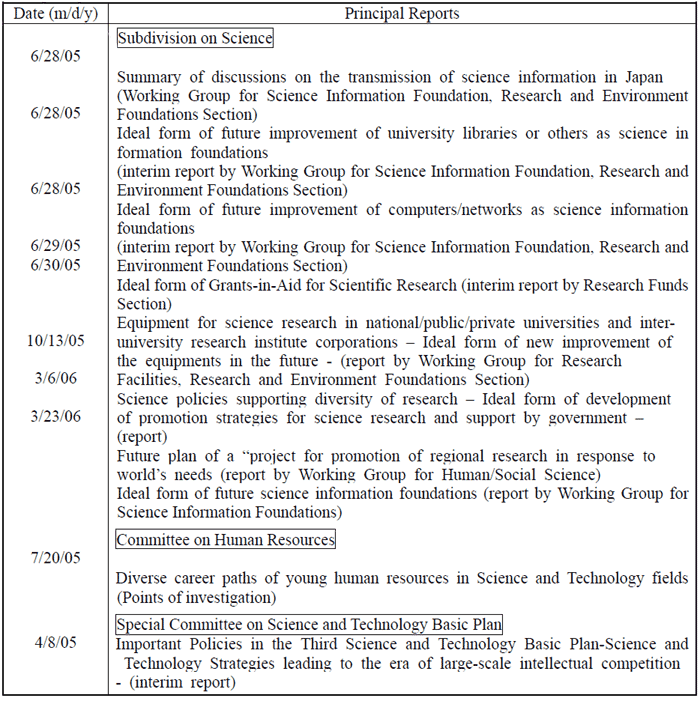
3.1.3.2 Budget for Science and Technology
The Second Basic Plan aims to expand the funding required for the promotion of the measures raised in the Basic Plan based on prioritized and efficient allocation of funding, taking into account future socioeconomic trends, as well as the need for the promotion of science and technology.
In Fiscal 2005, Japan’s budget for science and technology totaled 3.5779 trillion yen. Of this total, the general account budget was 2.9515 trillion yen, while the special account budget was 626.4 billion yen. In the general account budget, the amount singled out for the promotion of science and technology was 1.317 trillion yen (Table 3-1-7).
Trends in the budget for science and technology by ministry or agency are shown in Table 3-1-8.
Since the administration of science and technology in Japan is spread among a large number of ministries and agencies, there is a need for the coordination of science and technology measures between the relevant ministries and agencies that can eliminate unnecessary duplication and promote stronger cooperation, so as to ensure consistency among ministries as a whole, and to efficiently and effectively promote science and technology.
For this reason, the Council for Science and Technology Policy conducts overall coordination to ensure that important measures stipulated in the Science and Technology Basic Plan are properly and firmly realized throughout Japan, by formulating policies on allocation of the budget, human and other resources related to science and technology and prioritizing science- and technology-related measures of relevant ministries and agencies after budget requests are made. In addition, the Ministry of Education, Culture, Sports, Science and Technology contacts the relevant ministries and agencies each fiscal year, before budget requests for science and technology related expenditures are made, to hear the reasoning behind their budget requests. The ministry then coordinates with the ministries and agencies to eliminate any duplication and to promote inter-ministerial cooperation, as part of government-wide efforts.
Table 3-1-7 Trends in the Science and Technology Expenditures
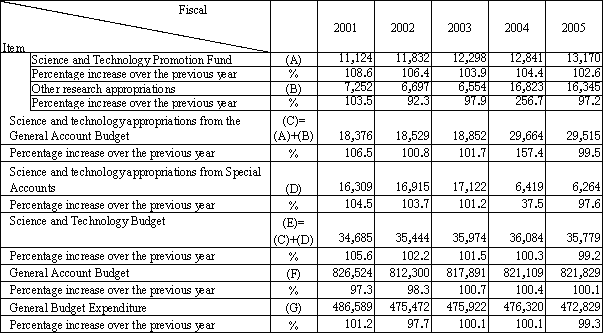
Notes 1:
Amounts shown for Other research appropriations (B)
and Science and technology appropriations from Special Accounts (D) are MEXT's
estimates.
Notes 2:
All amounts represent initial budgets or appropriations for the
respective fiscal year.
Notes 3:
Since amounts have been rounded, the sum of the amounts and percentages
for each column and the totals and percentages shown above do not necessarily
agree.
Notes 4:
Of the expenditures related to science and technology in the general
accounts budget for FY2004 and FY2005, those for national university corporations,
etc. were calculated from the aggregate of subsidies for administrative costs,
grants for facility maintenance costs, and self generated income. (The amount
corresponds to the science and technology budget in the National Schools Special
Account (abolished at the end of FY2003)). The same in Table 3-1-8.
Notes 5:
Based on policies of the Second Science and Technology Basic Plan,
the subjects of calculation were revised starting in FY2001.
Table 3-1-8 Science and Technology Expenditure Breakdown by Ministry and Agency
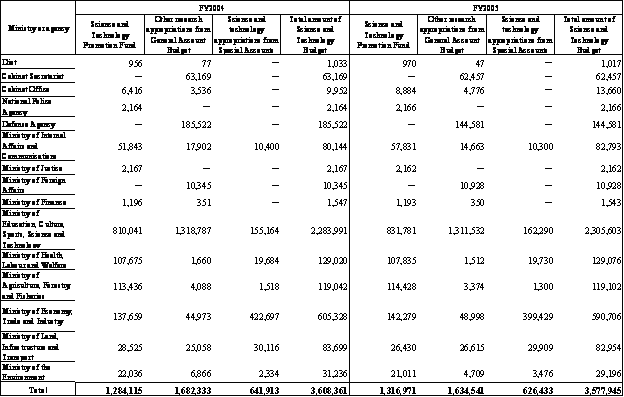
Notes 1:
All amounts represent initial expenditures or appropriations
for the respective fiscal year.
Notes 2:
Since amounts have been rounded off, the sum of the amounts for
each column and the totals shown above do not necessarily agree.
Notes 3:
Overlapping is avoided in total amounts, but some amounts include
overlapping expenditures.
Contacts
Research and Coordination Division, Science and Technology Policy Bureau
(Research and Coordination Division, Science and Technology Policy Bureau)




